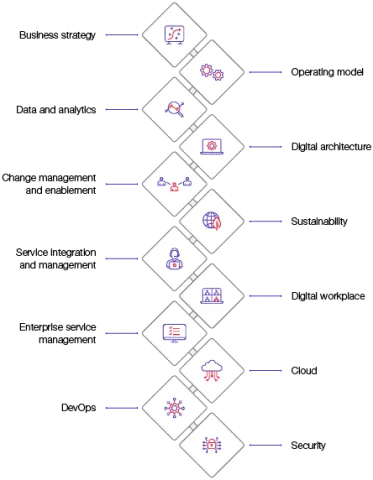Harnessing the power of digital transformation requires a strategic approach that goes beyond simply adopting new IT.
When designed effectively, a digital backbone becomes the cornerstone of a successful modern organisation. It facilitates all your processes and functions, making them more efficient, effective, and scalable to thrive in our ever-evolving world.
That’s because a digital backbone starts by aligning your strategy and organisational imperatives, then purposefully applying technology throughout your enterprise. This value-led approach to digitalisation creates an agile operating model that supports your desired outcomes:
Developing a digital backbone is therefore essential to navigate the complexities of digitalisation, helping you unlock new opportunities and create an IT-enabled foundation for your organisation’s continuous growth. That’s why we developed the Digital Backbone, our end-to-end framework that makes IT the enabler of your success.
The Digital Backbone
Our proven, end-to-end approach for digital transformation success
Our Digital Backbone delivers best practices and lessons learned, inspiring your digital journey with twelve fundamental building blocks. These help you envision secure and sustainable strategies and solutions that make technology the driving force behind your organisation’s overall success.
The Digital Backbone is therefore business-led and technology-enabled, meaning your specific organisational goals are the primary drivers of your strategy, with technology serving to achieve these objectives.
Combined, your new capabilities will create a robust, IT-enabled structure – a digital backbone – that transforms everything you do, empowering you to overcome challenges, achieve business goals, and enabling your organisation to thrive in our ever-evolving world.
Alternatively, the Digital Backbone’s twelve propositions can be implemented individually to address more specific challenges and ambitions, so no matter where you are on your transformation journey, you have a comprehensive vision for success.
- Business strategy
-
Develop a clear and aligned digital strategy that leverages technology to achieve your organisational goals.
- Operating model
-
Design an operating model that supports digital transformation, including restructuring processes, roles and responsibilities.
- Data and analytics
-
Implement advanced analytics capabilities using data-driven insights to inform decisions and drive continuous improvement.
- Digital architecture
-
Create a robust digital capability that supports your strategic initiatives, selecting the right platforms, tools and technologies.
- Change management and enablement
-
Foster a culture where your people can embrace new processes and technologies, enabled by effective change management strategies.
- Sustainability
-
Integrate sustainable practices into your digital transformation efforts to reduce environmental impact and promote responsible technology use. Learn more
- Service integration and management (SIAM)
-
Ensure seamless integration of your various in-house and external systems, enabling service quality and efficiencies.
- Digital workplace
-
Enhance service quality and customer and citizen experiences, fostering organisational growth with employee-focused digital transformation.
- Enterprise service management
-
Develop a comprehensive approach to efficiently manage enterprise services, aligned to your organisational goals.
- Cloud
-
Use cloud technologies to enhance scalability, flexibility, and cost efficiencies in line with your digital transformation objectives and business needs.
- DevOps
-
Streamline software deployment by fostering collaboration between development and operations teams, accelerating delivery and quality.
- Security
-
Implement robust measures to protect your assets, data and reputation, ensuring a strong cyber security posture whilst embracing digital transformation.

